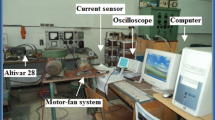Abstract
Machinery can undergo many different types of operational faults during use. Mitigating these faults through scheduled maintenance programs or upon failure is costly, inefficient, and can introduce safety hazards. An alternative approach to identifying abnormal behavior in mechanical systems is through condition based monitoring, which is applied by taking measurements of machinery and using spectral analysis to diagnose faults. The signals produced by machines contain characteristic frequencies describing the operating state. The application of local sensors to monitor the health of mechanical systems is often expensive or not feasible; it is of interest to find methods of remote sensing to allow for detection of abnormalities in mechanical systems without the need for sensors at the local point of operation. This work intends to utilize the method of remote detection to study the diminishment of fault feature observability as a function of sensor location relative to operating equipment. In this study, the procedure used for fault detection consists of the following: (1) collect signals for rotating machinery operating in a healthy, faulty, and off state (2) identify features that are unique to a faulty operating state (3) use those features to identify faulty behavior. This procedure is performed at three locations. For each location, the observable feature for a healthy, faulty and motor off state is calculated and compared using the statistical mean, standard deviation, p-value and Bhattacharyya distance. The relationship between fault observability and distance is presented as a function of Bhattacharyya distance and classified based on a one-way ANOVA test. Machine fault diagnosis becomes more difficult as the measurement location increases. At greater distances, there is no statistical significance between healthy and faulty machine operation. Using a predictable frequency response, machine faults can be correctly identified up to a certain threshold determined by environment noise.
Access this chapter
Tax calculation will be finalised at checkout
Purchases are for personal use only
Similar content being viewed by others
References
Farrar, C.R., Worden, K.: Structural Health Monitoring: A Machine Learning Perspective. Wiley, Hoboken (2013)
SpectraQuest Inc, Applied Vibration Analysis Training Manual & Laboratory Exercises, Richmond, VA
Mogal, S., Lalwani, D.: A brief review on fault diagnosis of rotating machinery. Appl. Mech. Mater. 541–542, 635–640 (2014)
Kryer, R., Haynes, H.: Condition monitoring of machinery using motor current signaure analysis. In: Power Plant Dynamics, Control and Testing Symposium, vol. 7 (1989)
Filho, P.C., Brito, J.N., Silva, V.A., Pederiva, R.: Detection of electrical faults in induction motors using vibration analysis. J. Qual. Maint. Eng. 19(4), 364–380 (2013)
Singh, S., Kumar, A., Kumar, N.: Motor current signature analysis for bearing fault detection in mechanical systems. Procedia Mater. Sci. 6, 171–177 (2014)
Thomson, W.T., Orpin, P.: Current and vibration monitoring for fault diagnosis and root cause analysis of induction motor drives. In: Proceedings of the Thirty-First Turbomachinery Symposium, pp. 61–67 (2002)
Dykas, B., Becker, A.: Comparison of measurement techniques for remote diagnosis of damage in non-HUMS-equipped bearings. IEEE Aerospace Conference, pp. 1–16 (2016)
Siemens. What is a Frequency Response Function (FRF)? Siemens PLM Community (2016)
Zhou, Y.-L., Figueiredo, E., Maia, N., Perera, R.: Damage detection and quantification using transmissibility coherence analysis. Shock. Vib. 2015, 290714, 16 pp. (2015)
Konar, P., Chattopadhyay, P.: Bearing fault detection of induction motor using wavelet and Support Vector Machines (SVMs). Appl. Soft Comput. 11, 4203–4211 (2011)
Chen, F., Tang, B., Chen, R.: A novel fault diagnosis model for gearbox based on wavelet support vector machine with immune genetic algorithm. Measurement. 46, 220–232 (2013)
Yan, R., Gao, R.X., Chen, X.: Wavelets for fault diagnosis of rotary machines: a review with applications. Signal Process. 96, 1–15 (2014)
Marmugi, L., Gori, L., Hussain, S., Deans, C., Renzoni, F.: Remote detection of rotating machinery with a portable atomic magnetometer. Appl. Opt. 57(3), 743 (2017)
Hall, D.L., LLinas, J.: An introduction to multisensor data fusion. Proc. IEEE. 85(1), 6–23 (1997)
Safizadeh, M., Latifi, S.: Using multi-sensor data fusion for vibration fault diagnosis of rolling element bearings by accelerometer and load cell. Inform. Fusion. 18, 1–8 (2014)
Dash, M., Lui, H.: Feature selection for classification. IDA Elsevier Intelligent Data Analysis. 1(97), 131–156 (1997)
Ngolah, C.F., Morden, Ed, Wang, Y.: An intelligent fault recognizer for rotating machinery via remote characteristic vibration signal detection. In: IEEE 10th International Conference for Cognitive Computing (2011)
Danforth, S.M., Martz, J.T., Root, A.H., Flynn, E.B., Harvey, D.Y.: Multi-source sensing and analysis for machine-array conditioning monitoring. In: Structural Health Monitoring & Damange Detection, vol. 7, pp. 9–21 (2017)
Choi, E., Lee, C.: Feature extraction based on the Bhattacharyya distance. Pattern Recogn. 36(8), 1703–1709 (2003)
Lee, C., Choi, E.: Bayes error evaluation of the Gaussian ML classifier. IEEE Trans. Geosci. Remote Sens. 38(3), 1471–1475 (2000)
Author information
Authors and Affiliations
Corresponding author
Editor information
Editors and Affiliations
Rights and permissions
Copyright information
© 2019 Society for Experimental Mechanics, Inc.
About this paper
Cite this paper
Colford, G., Jacobson, E., Plewe, K., Flynn, E., Wachtor, A. (2019). Remote Detection of Abnormal Behavior in Mechanical Systems. In: Niezrecki, C., Baqersad, J., Di Maio, D. (eds) Rotating Machinery, Optical Methods & Scanning LDV Methods, Volume 6. Conference Proceedings of the Society for Experimental Mechanics Series. Springer, Cham. https://doi.org/10.1007/978-3-030-12935-4_6
Download citation
DOI: https://doi.org/10.1007/978-3-030-12935-4_6
Published:
Publisher Name: Springer, Cham
Print ISBN: 978-3-030-12934-7
Online ISBN: 978-3-030-12935-4
eBook Packages: EngineeringEngineering (R0)




